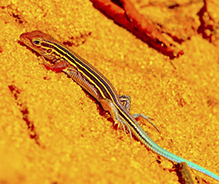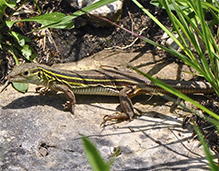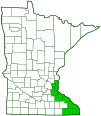Six-lined Racerunner
(Aspidoscelis sexlineatus)
Conservation • Description • Habitat • Biology • Distribution • Taxonomy
Conservation Status |
|
|||||||
| IUCN Red List | LC - Least Concern |
|||||||
| NatureServe | N5 - Secure S4 - Apparently Secure |
|||||||
| Minnesota | not listed Species in Greatest Conservation Need |
|||||||
Description |
||
Six-lined racerunner is a whiptail lizard. It occurs in the United States from Maryland to Florida west to the Great Plains, and in Mexico. It is found in areas of sparse vegetation on open prairies with sandy or gravelly soil, on rocky bluffs, and on roadsides, railroads, and power lines. In Minnesota it occurs on the blufflands and river terraces in the southeast. It is found mostly on south-facing bluffs, in river floodplains, and on sandy outwashes. Populations tend to be localized and isolated. Minnesota does not give it a protected status but lists it as a Species in Greatest Conservation Need. Adults are active from mid-May to late August. They are opportunistic insectivores and will eat most arthropods, especially grasshoppers and crickets, but also beetle larvae, ants, spiders, and mollusks. Of the three lizards native to Minnesota, Six-lined Racerunner is the largest. Adults are 6″ to 10½″ (15.2 to 26.7 cm) in length, including the tail. Males are larger than females. The body is slender. The tail is long, accounting for 70% of the total length, and is whip-like. This is the feature that gives the genus its common name. The snout is pointed. The hind legs are large and have long toes. Scales on the upper part of the body are rough, pellet-like, and dull, not shiny. Scales on the belly are smooth. There are three light yellow or yellowish-green longitudinal stripes on each side. This is the feature that gives the racerunner its common name. The back is brown in the middle, dark brown to black between the stripes on the sides. The belly is light blue on the male, white on the female. During mating season males develop a bright green or blue tint on their sides and head. Juveniles are similar to females but have bright green stripes and powder blue tails. |
||
Size |
||
6″ to 10½″ (15.2 to 26.7 cm) |
||
Similar Species |
||
Five-lined skink (Plestiodon fasciatus) has just two stripes on each side and a dorsal stripe that splits to form a Y shape on the top of the head. Prairie skink (Plestiodon septentrionalis) has just two stripes on each side. |
||
Habitat |
||
Areas of sparse vegetation on open prairies with sandy or gravelly soil, on rocky bluffs, and on roadsides, railroads, and power lines |
||
Biology |
||
Behavior |
||
Adults are most active in the morning. They bask on rocks in the afternoon and spend the night in a burrow. They move with short, quick, bursts of speed. When attacked by a predator, the racerunner will detach its all or part of its tail. The tail will continue to wiggle and distract the predator while the racerunner seeks cover. The tail will regrow but will not be as long as the original. |
||
Lifespan |
||
5 to 7 years |
||
Life Cycle |
||
Six-lined racerunners have a short season of activity. The range of temperatures at which they can be active (thermal activity range) is the highest of any reptile in the eastern Unites States. They are the last common reptile species to emerge in the spring, they are most active in late spring and early summer, and activity drops off in July. Adults and they are rarely seen above ground after mid-August. Juveniles are active until early October. To overwinter, they burrow into the soil to a depth where the temperature is fairly stable. When the temperature drops in the fall, they become semitorpid. In the winter, they become truly dormant. Adults emerge in mid-May. Breeding occurs in late spring or early summer. The female lays up to six but usually just four eggs. Gestation lasts 36 to 40 days. |
||
Food |
||
Arthropods, especially grasshoppers and crickets, but also beetle larvae, ants, spiders, and mollusks |
||
Distribution |
||||
|
Sources |
|||
| 9/7/2021 | ||||
Occurrence |
||||
Uncommon in Minnesota |
||||
Taxonomy |
|||
| Class | Reptilia (Reptiles) | ||
| Superorder | Lepidosauria | ||
Order |
Squamata (Snakes and Lizards) | ||
Suborder |
Lacertilia (lizards) | ||
Infraorder |
Scincomorpha (skinks, wall lizards, and relatives) | ||
Superfamily |
Lacertoidea | ||
Family |
Teiidae (whiptails and tegus) | ||
| Subfamilt | Teiinae (whiptails and ameivas) | ||
Genus |
Aspidoscelis (whiptail lizards) | ||
Until recently, this lizard was included in the genus Cnemidophorus. In 2002 it was transferred along with more than 40 other species in that genus to Aspidoscelis. |
|||
Subordinate Taxa |
|||
eastern Six-lined Racerunner (Aspidoscelis sexlineatus sexlineatus) Texas yellow-headed racerunner (Aspidoscelis sexlineatus stephensae) prairie racerunner (Aspidoscelis sexlineatus viridis) |
|||
Synonyms |
|||
Aspidoscelis sexlineata Cnemidophorus sexlineatus Lacerta sexlineata |
|||
Common Names |
|||
Six-lined Racerunner |
|||
Visitor Photos |
|||||
Share your photo of this reptile. |
|||||
| This button not working for you? Simply email us at info@MinnesotaSeasons.com. Attach one or more photos and, if you like, a caption. |
|||||
Scott Leddy |
|||||
I noticed you don’t have a six lined racerunner page, so here are a picture of a juvenile and a male. |
|||||
Juvenile |
 |
||||
| Male |  |
||||
MinnesotaSeasons.com Photos |
|||||
|
|||||

Slideshows |
||

Visitor Videos |
|||
Share your video of this reptile. |
|||
| This button not working for you? Simply email us at info@MinnesotaSeasons.com. Attach a video, a YouTube link, or a cloud storage link. |
|||
Other Videos |
|||
| Six-lined Racerunner TheSnakeLibrary |
|||
About
May 5, 2012 Six-lined Racerunner Description: 6 - 9.5 in (15 - 24 cm). Although the Six-lined Racerunner is the only lizard in our area with six light yellow or white stripes down its back, the racerunner's ground-dwelling habits and impressive speed are often sufficient to identify this species from a distance. Range and Habitat: The Six-lined Racerunner is a common lizard throughout Georgia and South Carolina, but is absent from some areas in the mountains. This species is most common in hot, open areas such as fields, woodland edges, and sand dunes and is almost always found on the ground. Habits: Racerunners are fond of heat and are active even on the hottest of summer days. They are alert and active, darting between clumps of vegetation to grab insects. During cool weather, night, or when confronted by a predator, racerunners often take refuge in burrows. Prey: Six-lined racerunners eat a wide variety of insects, spiders, and other invertebrates. Reproduction: Female racerunners lay 1 - 5 eggs in a shallow nest in the summer. Young resemble adults and lack the bright blue tails of the skinks. Abundance: In hot, open habitats racerunners are often the most common lizards. However, they are almost never found in moist, shady habitats such as thick forests or river swamps. Notes: Racerunners are extremely fast, making them some of the most difficult lizards to capture. |
|||

Visitor Sightings |
|||||
Report a sighting of this reptile. |
|||||
| This button not working for you? Simply email us at info@MinnesotaSeasons.com. Be sure to include a location. |
|||||
| Scott Leddy | Location: Fillmore County I noticed you don’t have a six lined racerunner page, so here are a picture of a juvenile and a male. |
||||
MinnesotaSeasons.com Sightings |
|||||
|
|||||

Created: 9/7/2021
Last Updated:

